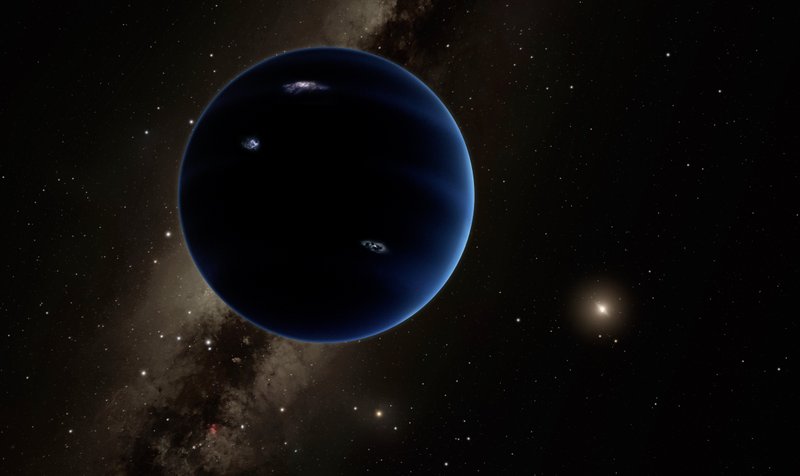Among some astronomers, suspicion is growing that the solar system's distant reaches conceal a large, ninth planet that we have not yet seen. New findings about a small ice world far beyond Pluto buttress this idea.
On Oct. 1, astronomers led by Scott Sheppard of the Carnegie Institution for Science in Washington revealed the orbital details of the little ice world, which they have nicknamed the Goblin. Sheppard and his colleagues first spotted it in 2015, as part of a systematic search for new worlds in the outer system, including the hypothesized Planet Nine.
Sheppard said Goblin is on the small end for a dwarf planet. It is officially known as 2015 TG387 by the International Astronomical Union's Minor Planet Center.
This is the third dwarf planet recently found to be orbiting on the frigid fringes of our solar system.
Goblin's orbit is extremely elongated — so stretched out that it takes 40,000 years for it to circle the sun. At its closest, the Goblin is 65 times farther from the sun than Earth.
Only with more observations did the researchers realize how far out TG387 really is. "It took us three years to figure out that it has an interesting orbit," Sheppard said.
The astronomers have submitted a paper describing the discovery to The Astronomical Journal.
Estimated to have a width of 186 miles, Goblin is currently about 7.4 billion miles from the sun, or about 2.5 times farther away than Pluto. But that is almost the closest it ever gets to the sun.
At the other, most distant end of its elliptical orbit, TG387 is nearly 70 times farther from the sun than Pluto — more than 200 billion miles.
To put that in perspective, pretend that you could shrink the solar system so that the sun was in New York and Pluto in Los Angeles. Then TG387's current location would be in the Pacific, a more distant trip than New York to Honolulu. At TG387's most distant spot in its orbit, the distance to get there would be like circling the earth seven times, or going three-quarters of the way to the moon.
The fact that TG387 remains far beyond the pull of the gravitational heavyweights of the solar system — Jupiter, Saturn, Uranus and Neptune — raises the question of how it was thrown into its current orbit.
Astronomers — including Sheppard's team in 2014 — have discovered several bodies with such distant, stretched-out orbits. The orbits of these objects seem not to be random.
In 2016, Michael Brown and Konstantin Batygin of the California Institute of Technology, published a detailed prediction of what they called an unseen planet, bigger than Earth yet smaller than Neptune, that was shepherding the movement of these distant worlds and could explain their odd journeys around the sun.
They named it Planet Nine.
Ann-Marie Madigan, an astronomer at the University of Colorado, has suggested that gravity from a massive ring of small worlds early in the solar system's history could explain the distant orbits. Madigan's ideas could help explain how the ice worlds were cast out there, but not any clustering in their orbits.
"This new object does look like it's quite good for the Planet Nine theory," she said.
Brown agreed. He is known best for his role in Pluto's demotion to the status of a dwarf planet and is leading his own search for Planet Nine.
"Mostly it's just another piece that fits in the puzzle very nicely," he said.
For almost all of its orbit, Goblin would be too dim to be seen by any telescope on Earth. Thus, either the astronomers were extremely lucky to find an oddball at the rare moment it was visible — or actually it is just one of a multitude of similar worlds, with a few happening to be close enough to be seen.
"We think there are thousands of these, and most of them are too distant to detect," Sheppard said.
He said that there might even be a million bodies 30 miles wide and larger, with a cumulative mass equal to one-tenth of Earth's, orbiting in the so-called Inner Oort Cloud.
Still, the existence of Planet Nine remains unproved. "I would say it's more likely than not," Sheppard said. "It's not a slam dunk."
Some information in this report is from Marcia Dunn of The Associated Press.
Style on 10/08/2018
